Kingdom Fungi Subdivision Pezizomycotina Rank Species | Family Lasiosphaeriaceae | |
Similar Podospora, Neurospora crassa, Neurospora, Sordaria, Sordaria macrospora | ||
Podospora anserina is a model filamentous, ascomycete fungus. It is non-pathogenic to humans. It is a herbivore dung-colonizing (coprophilous) fungus. It is heterothallic.
Contents
- Taxonomy
- Research
- Strains
- Aging
- Heterokaryon incompatibility
- Enzymes
- Genetics
- Morphology
- Secondary metabolites
- References
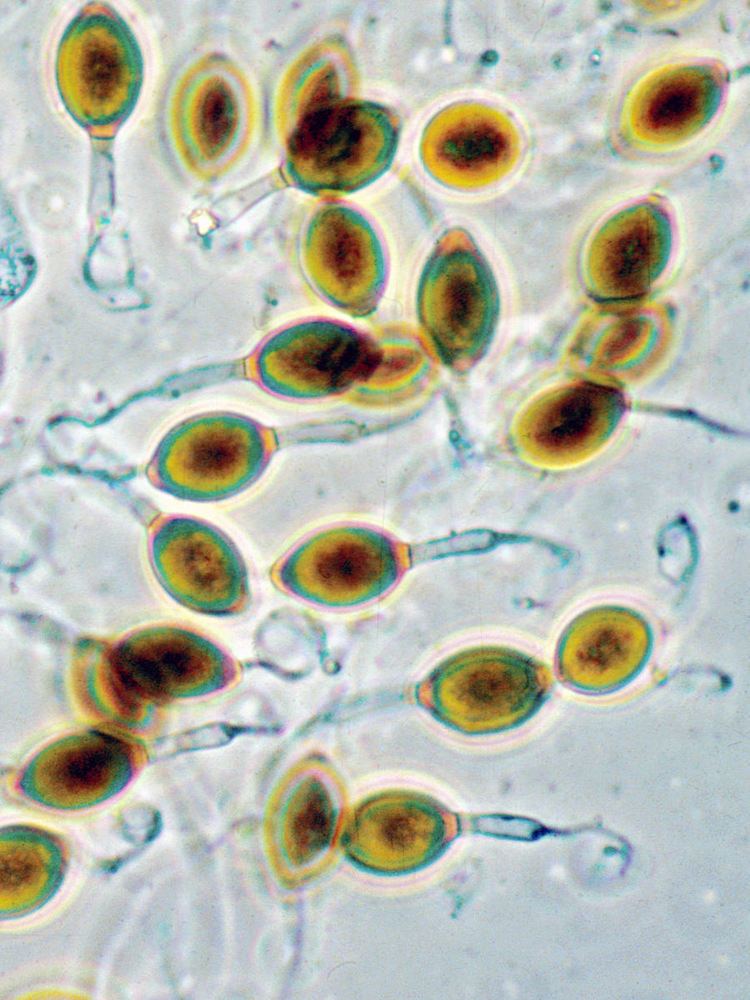
Taxonomy
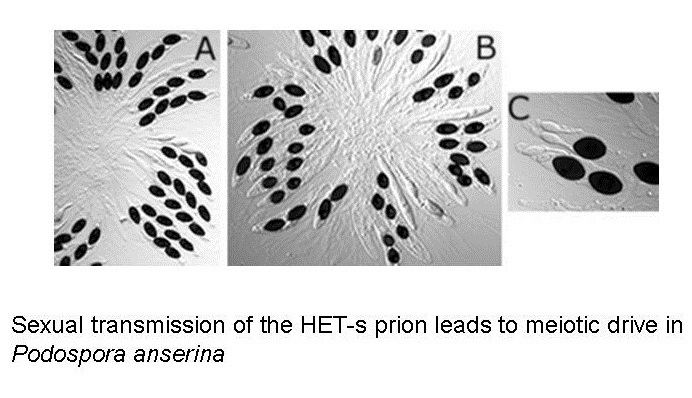
Podospora anserina had the original name Malinvernia anserina Rabenhorst (1857) and Podospora anserina was subsequently published in Niessl von Mayendorf, G. 1883: Ueber die Theilung der Gattung Sordaria. Hedwigia 22: 153-156, which is used today to reference the common laboratory strain therefrom, namely, 'Niessl'. It is also known as Pleurage anserina (Ces.) Kuntze. Genetics of P. anserina were characterized in Rizet and Engelmann (1949) and reviewed by Esser (1974). P. anserina is estimated to have diverged from N. crassa 75 million years ago based on 18s rRNA and protein orthologous share 60-70% homology. NCBI Taxonomy ID: 5145, MycoBank # 100818 Gene cluster orthologs between Aspergillus nidulans and Podospora anserina have 63% identical primary amino acid sequence (even those these species are from distinct classes) and the average amino acid of compared proteomes is 10% less, giving rise to hypotheses of distinct species yet shared genes
Research
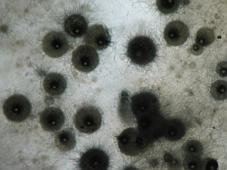
Podospora as a model organism to study genetics, aging (senescence, cell degeneration), ascomycete development, heterokaryon incompatibility (Mating in fungi), prion (disease), and last, but not least, mitochondrial and peroxisomal physiology. Podospora is well culturable in lab (for example, on/in complex (full) potato dextrose or cornmeal agar/broth or even synthetic medium), and, using modern molecular tools, easy to manipulate. Its optimal growth temperature is 25-27 °C.
Strains
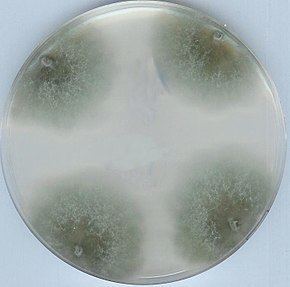
Aging
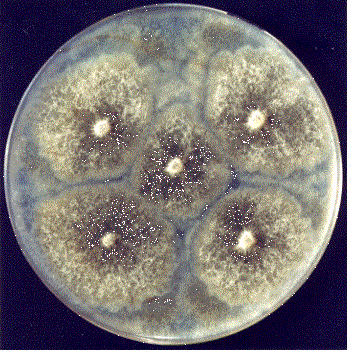
Podospora anserina has a definite life span and shows phenotypically senescence (slower growth, less aerial hyphae and increased pigment production in distal hyphae), however, isolates show either increased life span or immortality. To study the process of aging many genetic manipulations to produce immortal strains or increase life-span have been done. In general, the mitochondrion and mitochondrial chromosome is investigated (note that animals, closely related to fungi, contain similar organelles like mitochondria). This is because during respiration reactive oxygen species are produced that limit the life span and over time defective mitochondrial DNA can accumulate. With this knowledge, much focus turned to nutrition availability, respiration (ATP synthesis) and oxidases, like cytochrome c oxidase. Carotenoids, pigments also found in plants and provide health benefits to humans, are known to be in fungi like Podospora's divergent ancestor Neurospora crassa. In N. crassa (and other fungi) cartenoids al genes, namely focused provide UV radiation protection. Overexpressed of al-2 Podospora anserina increased life span by 31%. Calorie restriction studies show that decreased nutrition, like sugar, increase life span (likely due to slower metabolism and thus decreased reactive oxygen species production or induced survival genes). Also, intracellular copper levels were found to be correlated with growth. This was studied in Grisea-deleted and ex1-deleted strains, as well as in a wild type s strain. Podospora without Grisea, a cooper transcription factor, had decreased intracellular copper levels which lead to use of an alternative respiratory pathway that consequently produced less oxidative stress.
Heterokaryon incompatibility
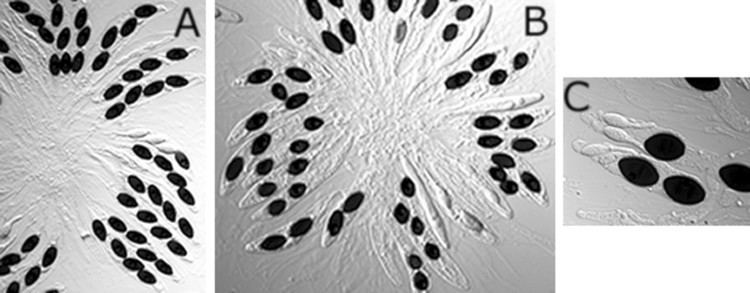
The following genes, both allelic and nonallelic, are found to be involved in vegetative incompatibility (only those cloned and characterized are listed): het-c, het-c, het-s, idi-2, idi-1, idi-3, mod-A, mode-D, mod-E, psp-A. Podospora anserina contains at least 9 het loci.
Enzymes
Podospora anserina is known to produce laccases, a type of phenoloxidase.
Genetics
Original genetic studies by gel electrophoresis led to the finding of the genome size, ca. 35 megabases, with 7 chromosomes and 1 mitochondrial chromosome. In the 1980s the mitochondrial chromosome was sequenced. Then in 2003 a pilot study was initiated to sequence regions bordering chromosome V`s centromere using BAC clones and direct sequencing. In 2008, a 10x whole genome draft sequence was published. The genome size is now estimated to be 35-36 megabases. Genetic manipulation in fungi is difficult due to low homologous recombination efficiency and ectopic integrations (insertion of gene at undesirable location) and thus a hindrance in genetic studies (allele replacement and knockouts). Although in 2005, a method for gene deletion (knock-outs) was developed based on a model for Aspergillus nidulans that involved cosmid plasmid transformation, a better system for Podospora was developed in 2008 by using a strain that lacked nonhomologous end joining proteins (Ku (protein), known in Podospora as PaKu70). This method claimed to have 100% of transformants undergo desired homologous recombination leading to allelic replacement (after the transformation, the PaKu70 deletion can be restored by crossing over with a wild-type strain to yield progeny with only the targeted gene deletion or allelic exchange (e.g. point mutation)).
Morphology
Morphology depends on the specific strain.
Secondary metabolites
It is well known that many organisms across all domains produce secondary metabolites and within the kingdom fungi there is no exception, as fungi are known to be prolific in this regard. Product mining was well underway in the 1990s for the genus Podospora. Specifically for Podospora anserina, two new natural products classified as pentaketides, specifically derivatives of benzoquinones, were discovered; these showed antifungal, antibacterial, and cytotoxic activities. Horizontal gene transfer is common in bacteria and between prokaryotes and eukaryotes yet is more rare between eukaryotic organisms. Between fungi, secondary metabolite clusters are good candidates for HGT. For example, a functional ST gene cluster that produces sterigmatocystin was found in Podospora anserina and originally derived from Aspergillus. This cluster is well-conserved, notably the transcription-factor binding sites. Sterigmatocystin itself is toxic and is a precursor to another toxic metabolite, aflatoxin.
